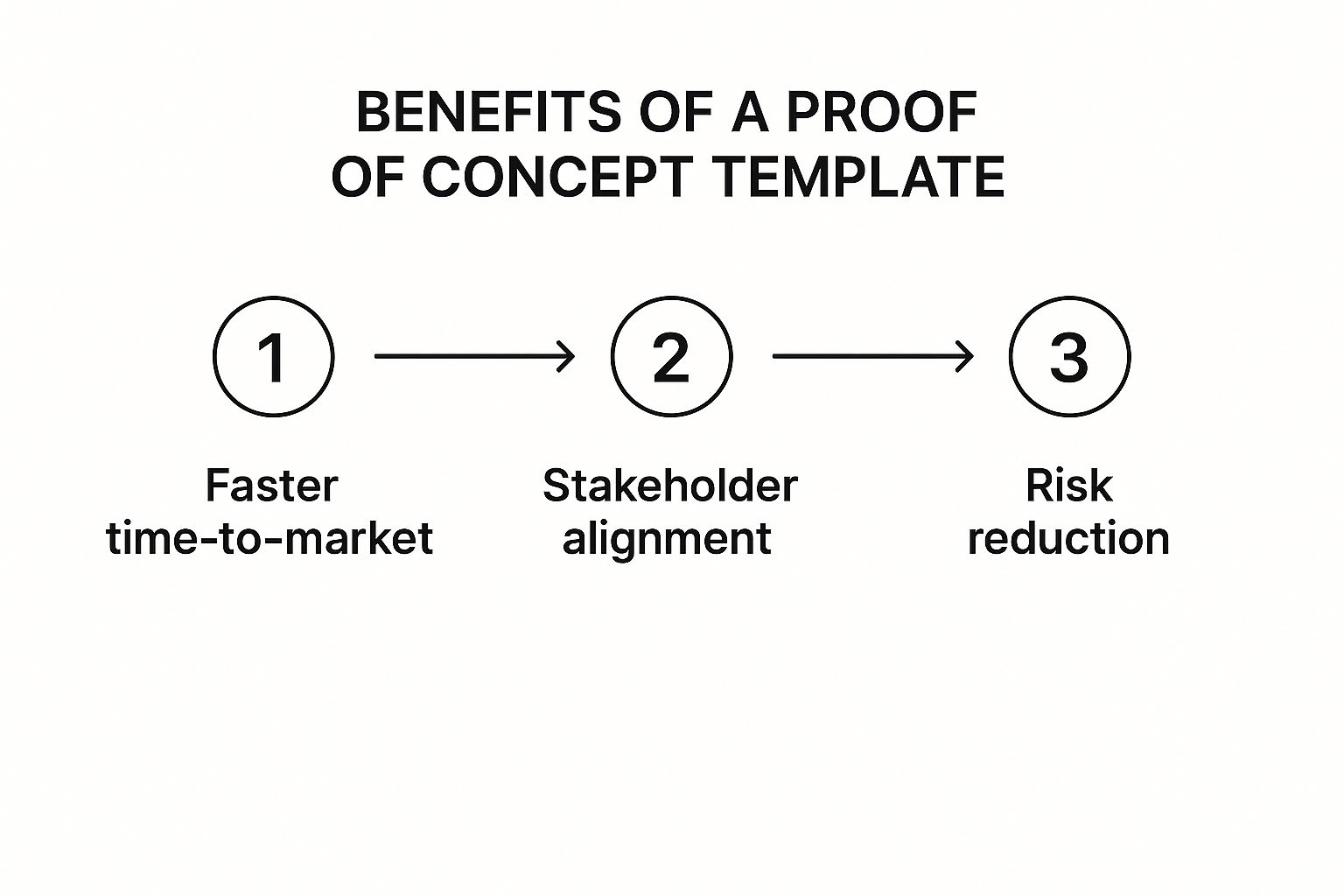A Proof of Concept Template That Actually Works
Think of a proof of concept template as a structured blueprint for your next big idea. Before you sink serious time, money, and energy into a project, a PoC forces you to slow down and answer the tough questions. It's the framework that helps you define what success actually looks like, outline the project's boundaries, and get everyone on the same page.
Frankly, using a proven proof of concept template is the single fastest way to secure buy-in from stakeholders and dodge those expensive, time-sucking missteps down the road.
Why a Solid PoC Template Is Your Secret Weapon

Before you build anything, you have to prove it’s worth building. This is where a proof of concept stops being a bureaucratic document and becomes a critical strategic tool. It's not about checking a box; it's about creating a clear communication bridge between your technical team and the business decision-makers.
When everyone is working from the same structured template, you'll find that alignment happens almost automatically. You’re no longer stuck debating vague ideas in a conference room. Instead, you're all looking at the same concrete goals, defined success metrics, and a crystal-clear scope. I've found this simple act of standardization is one of the most powerful ways to kill scope creep before it even starts.
Grounding Ideas in Reality
Let's take a real-world example. Imagine a SaaS company is excited about adding a new AI-powered analytics feature. Without a PoC template, the team might just dive into coding based on a few enthusiastic meetings. But with a template, they're forced to pause and answer some critical questions first.
- The Problem: What specific, painful user problem does this new feature solve?
- Success Metrics: How will we actually measure success? Are we aiming for a 20% reduction in user clicks to get an answer, or a 15% increase in adoption for that part of the product?
- Technical Feasibility: Can our current infrastructure even handle the processing demands of the AI model, or are we setting ourselves up for failure?
Asking these questions transforms a "cool idea" into a grounded, viable project plan. It forces you to validate your assumptions and uncover potential roadblocks before a single line of code gets written. Considering that product failure rates can be as high as 70% in software startups, validating ideas early isn't just a good practice—it's essential for survival. You can find more great insights on project validation on Shopify's blog.
Real-World Impact Across Industries
This thinking isn't just for software developers. Picture a retail company wanting to overhaul its logistics with a new inventory management system. A PoC template would guide them to test the system in a controlled environment, like a single warehouse, before going all-in.
A well-structured PoC is less about proving you're right and more about discovering what's right. It shifts the focus from assumptions to evidence—the only real foundation for smart decision-making.
By defining a narrow scope and clear metrics—like reducing picking errors by 30% or shaving two days off inventory turnover—the team can collect hard data. This data-backed evidence makes for a much more compelling case for a full-scale rollout than any slick presentation ever could. Ultimately, the template becomes your go-to tool for making smarter, more confident business decisions.
Taking Apart a High-Impact PoC Template
Alright, let's get our hands dirty and break down what makes a proof of concept template actually work. A truly effective PoC isn't just a jumble of notes and ideas. It’s a structured, logical document where each section flows into the next, building a rock-solid case for your project. Think of it as your blueprint for turning a fuzzy idea into a validated, ready-to-go plan.
The beauty of a good structure is that it forces you to be honest with yourself and think through every angle before you start burning through time and money. It's the difference between saying, "I have a feeling this will work," and confidently stating, "Here's the evidence that shows it will work."
This visual really nails how a structured template helps you get from concept to reality faster by focusing on quick delivery, clear communication, and spotting risks early on.

As you can see, each piece feeds the next, creating a powerful cycle of efficiency that dramatically increases your odds of success.
To give you a clearer picture, I've put together a table that outlines the non-negotiable sections every PoC template should have. It's a quick reference for what to include and why it matters.
Essential Sections of a Proof of Concept Template
| Template Section | Purpose and Key Question Answered | Example Focus |
|---|---|---|
| Problem Statement | What specific pain point are we solving, and why does it matter? | "Sales team spends 5 hours/week manually logging call data, leading to errors." |
| Target Audience | Who exactly are we solving this problem for? | "Inside sales representatives with 2-5 years of experience." |
| Success Metrics | How will we know, with data, if this PoC was a success? | "Reduce manual data entry time by 75%." |
| Project Scope | What is in, and what is out of this PoC? | "IN: Automate call logging. OUT: New reporting dashboard." |
| Technical Approach | What's the high-level plan for building this? | "Build a Python script using the CRM's API to sync call logs." |
This framework isn't just about filling in blanks; it's about building a compelling argument from the ground up, making your vision clear and defendable.
The Problem Statement and Target Audience
Everything starts here. Your first job is to nail down the exact problem you’re solving and who you're solving it for. Vague statements won't cut it—you need to be ruthlessly specific.
For example, a weak problem statement is, "Our users need a better dashboard." A much stronger one sounds like this: "Our enterprise users spend an average of 12 minutes per session manually pulling data from three different dashboards, which causes major frustration and wastes time." See the difference?
Next, define your users with that same level of detail. Who are they? What keeps them up at night about this specific problem? Getting this right ensures you're focused on solving a real-world headache, not just chasing a cool technical idea.
Clear Success Metrics
How will you know if you've won? If you can't answer that question before you start, you're setting yourself up for failure. Success metrics have to be tangible, measurable, and agreed upon by everyone involved before any work begins.
Good metrics are always specific and quantifiable. Here are a few real-world examples:
- User Adoption: Get a 25% adoption rate from the pilot user group within the first 30 days.
- Performance: The prototype has to run a standard data query in under 500 milliseconds.
- Cost Reduction: The new automated workflow must cut down manual processing time by at least 40%.
By defining success upfront, you create a clear finish line. There's no room for debate or shifting goalposts once the work is done; either you hit the mark or you didn't.
This data-first mindset is a cornerstone of modern product development. Many frameworks aiming to reduce startup failure rates lean heavily on this kind of structured validation, starting with deep dives into user interviews and competitor analysis. This discipline is what connects your PoC to a genuine market need. For more on this, you can find great insights about building a structured proof of concept on Creole Studios.
Project Scope and Technical Approach
Defining scope is all about drawing a firm line in the sand. You have to be crystal clear about what this PoC will do and, just as importantly, what it won't do. This is your best defense against scope creep and keeps the team laser-focused on the core goal.
When it comes to the technical approach, you don't need to write a textbook. Just give a high-level overview of the tech stack, architecture, and the main components you plan to use. The idea is to show stakeholders that you've thought through the execution and that it's technically sound, without drowning them in jargon. Briefly explain why you chose this path—it proves you’ve considered the "how" just as much as the "what."
Telling a Story That Gets Stakeholder Buy-In

Let's be honest: a proof of concept filled with technical specs and dry data is forgettable. To get stakeholders to open their wallets, you need to tell a compelling story. Your PoC template should be structured to build a narrative that turns a technical document into an irresistible business case. The real goal here is to build momentum and get everyone genuinely excited about the project's potential.
It all kicks off with a powerful executive summary. Don't treat this as a formality—it’s your elevator pitch and your best shot at grabbing a busy executive's attention. Think of it as the movie trailer for your project. In just a few sentences, it has to answer the big questions: What's the problem we're solving? What's our solution? And what's the tangible business impact?
This section needs to be clear enough for a CEO to grasp in 30 seconds but intriguing enough to make them want to dive into the details.
Crafting a Clear Narrative Flow
Once you've hooked them with the summary, your proof of concept template needs to guide them on a logical journey. The key is to connect the data to the story you're telling. The structure should feel natural, flowing from the big-picture problem to your specific, tested solution.
I've found a simple narrative structure works best:
- The Problem: Start by painting a vivid picture of the pain point. Don't just state it; make it real. Use actual user quotes or hard data to show the friction.
- The Proposed Solution: Introduce your idea as the hero of the story. Show exactly how it swoops in to solve the problem you just laid out.
- The Validation: This is where you bring in the proof. Show, don't just tell. Instead of saying "the test went well," say, "We tested the prototype with 15 users, and 87% completed the target task 50% faster." See the difference?
- The Business Case: Finally, bring it all home by connecting the dots to business value. What does all this mean for revenue, cost savings, or customer loyalty?
Following this flow transforms your abstract idea into a concrete plan that’s easy for anyone to get behind.
A PoC that only proves technical feasibility has done half its job. A PoC that tells a story proves business viability and inspires action. It’s the difference between saying "it works" and "here’s why it matters."
Making Complex Information Digestible
Remember who you're talking to. Your audience is a mix of people—from deeply technical engineers to high-level business leaders. Your template has to speak to all of them, and that means making complex information easy to digest.
This is where you need to be smart about your language and visuals. Break down technical jargon into simpler terms or use analogies everyone can understand. For example, you might be testing integrations with third-party systems without having access to their live environments. This is a perfect place to explain how you can simulate those dependencies. If you want to get into the weeds on that, our guide on what is service virtualization is a great resource.
To keep your audience engaged and ensure your key points land, scatter visuals and data callouts throughout the document:
- Charts and Graphs: A simple bar chart showing performance improvements is more powerful than a paragraph of text.
- User Flow Diagrams: A quick visual map of the proposed user experience can clarify things instantly.
- Key Data Callouts: Pull out the most important numbers and make them bold: $50,000 in projected annual savings.
This approach makes your document scannable and impactful, turning your PoC into an undeniable case for moving forward.
Setting Success Metrics That Actually Matter
A proof of concept without clear goals is really just a shot in the dark. The success metrics section of your proof of concept template is where you draw the line in the sand—this is what separates a successful test from a failed one. It's how you turn "I think it works" into "The data proves it works," making that final go/no-go decision a whole lot easier.
Think of it this way: if you can't measure it, you can't prove it. Your metrics have to be crystal clear and, most importantly, agreed upon by every stakeholder before a single line of code is written. Getting this alignment upfront prevents the classic "shifting goalposts" problem and ensures everyone knows what a win looks like from day one.
Defining Your Key Performance Indicators
Success is rarely a single number. It’s usually a mix of technical performance, user feedback, and tangible business results. Your PoC needs to reflect that reality by tracking a handful of metrics across these key areas. This gives you a complete, 360-degree view of whether your idea is actually viable.
Technical Feasibility: Can we pull this off? These metrics are all about performance, stability, and how well the new piece plays with your existing systems. For example, you might aim for a new API endpoint to keep its average response time under 200ms during a load test.
User Acceptance: Will people actually use this thing? This is the human element. A solid metric here could be hitting a user satisfaction score of 8 out of 10 with a test group, or seeing 75% of testers complete a core task without needing help.
Business Viability: Does this make us money or save us time? At the end of the day, this is what the people signing the checks care about. A great example would be proving a new automated workflow cuts manual processing time by 30%, which directly translates to cost savings.
Taking this balanced approach ensures you’re not just proving something can be built, but that it should be built. Our article on data-driven testing strategies dives deeper into creating a culture around these kinds of measurements.
Real-World Examples of PoC Metrics
Let’s get practical. Say you're testing a new feature for your mobile app. In a mobile market projected to hit $935 billion in revenue by 2025, big companies use PoCs to make sure new features are rock-solid before they go live. This early validation is often the difference between a feature users love and one they ignore. You can find more insights on the power of PoCs in app development to see how others are doing it.
Here’s a sample of what the success criteria might look like for that new app feature:
| Metric Category | Specific KPI Example | Success Threshold |
|---|---|---|
| Performance | App launch time after feature integration | Must not increase by more than 10% from the current baseline. |
| User Engagement | Percentage of beta testers who use the new feature more than once | 60% or higher. |
| Error Rate | Number of crashes or critical bugs reported per session | Less than 0.5%. |
Success metrics are your project's compass. They don’t just tell you if you've reached your destination; they guide every decision along the way, making sure you're always heading toward creating real value.
When you define these benchmarks from the start, your team has clear targets to hit. Once the PoC is done, all you have to do is compare the results to this table. The data tells the story, making your final recommendation objective and easy to defend.
Adapting Your Template for Any Project

The best proof of concept template I've ever used was more like a chameleon than a statue. It needs to bend and reshape itself to fit the project at hand. After all, validating a new software feature is a completely different ballgame than testing a new internal workflow.
If your template is too rigid, you'll end up focusing on the wrong metrics and asking irrelevant questions. That completely defeats the purpose of running a PoC in the first place. The real secret is to keep a core structure—your problem statement, scope, and success metrics—but customize the guts of each section.
Think of it as a foundational blueprint where you can swap out the specific materials depending on what you’re building. This is the flexibility that turns a simple document into a powerful tool you can use across your entire organization.
Tech Product vs. Process Improvement PoCs
Let’s get practical and compare two common scenarios. Imagine one team is testing a new API endpoint while another is trying to validate a new employee onboarding process. Their PoCs are going to look wildly different, and they should.
A tech product PoC is going to be heavy on the technical details.
- Scope: You’ll likely see architecture diagrams, user flow mockups, and required performance benchmarks.
- Success Metrics: Here, you're tracking things like API response times, error rates, and integration compatibility. A critical goal might be proving the endpoint can handle 500 concurrent requests with less than a 1% failure rate.
- Resources: This section will list out specific technologies, developer hours, and the necessary testing environments. For technical teams, having a clear plan is non-negotiable, and a solid API documentation template can be a great starting point for defining those expectations.
On the other hand, a process improvement PoC is all about operational efficiency.
- Scope: This is where you’ll detail the pain points of the current workflow and map out the proposed new steps. Your visuals will be flowcharts, not wireframes.
- Success Metrics: You’re measuring business outcomes, like a 40% reduction in manual data entry, a jump in employee satisfaction scores, or cutting the onboarding timeline from five days down to just two.
- Resources: The focus shifts to people's time, training materials, and tools for gathering feedback, like surveys.
The core goal of a PoC remains the same: to reduce uncertainty with evidence. How you gather that evidence must change based on the question you're trying to answer.
Understanding this distinction is key. It ensures your proof of concept template always helps you zero in on what truly matters for that specific initiative. This focused approach stops you from wasting time on irrelevant details and helps you build a much stronger, more compelling business case when it’s time to share your findings.
Ultimately, the template provides the structure; you provide the context.
Answering Your Top Questions About PoC Templates
Whenever teams start working with a proof of concept template, the same questions tend to surface. Let's walk through the most common ones I hear, so you can sidestep confusion and get to work with confidence.
How Detailed Does a PoC Really Need to Be?
This is probably the number one question, and the answer is always: "just enough to prove your point." A PoC isn't meant to be a polished, feature-complete prototype. Its entire purpose is to validate a single, critical assumption.
For instance, if you're testing whether a new machine learning model can accurately predict customer churn, you'd focus exclusively on the model's performance and accuracy. You wouldn't waste a single minute building a fancy dashboard or a perfect user interface.
What's a Realistic Timeline for a PoC?
Another big one is timing. A PoC needs to be fast. We're talking a few days, maybe a couple of weeks at the absolute most. If your PoC is dragging on for months, you've drifted out of "proof of concept" territory and are now building a prototype. The whole point is to learn quickly, not to build perfectly.
PoC vs. Prototype: What's the Real Difference?
It’s easy to get these two mixed up, but they have fundamentally different goals. Getting this right from the start is crucial for managing stakeholder expectations and keeping your project on track.
A Proof of Concept (PoC) asks one simple question: "Can we even do this?" It’s all about technical feasibility. A PoC might be nothing more than a backend script that proves a core function works as expected—no UI required.
A Prototype, on the other hand, asks: "How would this actually work for a user?" This is where you get a tangible, interactive model that gives a feel for the user experience and the overall workflow.
Here's the bottom line: a PoC validates one key function, while a prototype shows how several of those functions come together in a way a user can actually see and interact with.
The most common pitfall I see is teams over-engineering their PoCs. They start adding bells and whistles that belong in a prototype, which just burns time and money, completely defeating the purpose of the exercise.
When you're putting together project documentation, it’s helpful to collect these kinds of questions and answers for your team. Using a structured FAQ template can be a great way to organize this information clearly. When everyone is on the same page, you avoid missteps and keep the momentum going.
Ready to build and test your next great idea without waiting on backend dependencies? dotMock lets you create realistic mock APIs in seconds. Simulate any scenario, from success cases to network failures, and accelerate your development cycle. Get started for free at dotmock.com and ship faster.